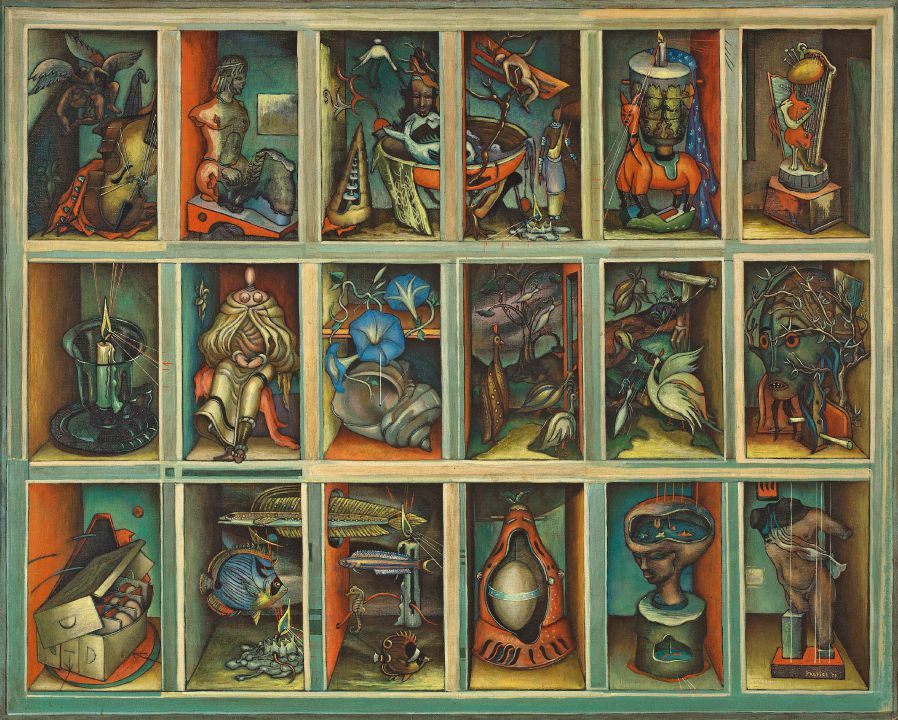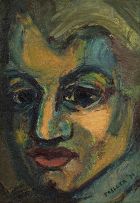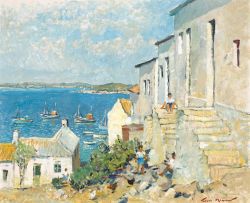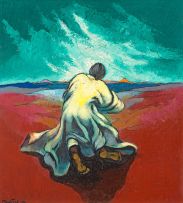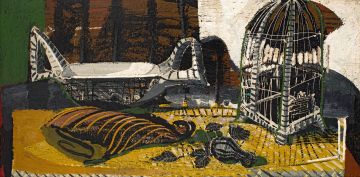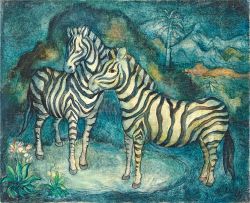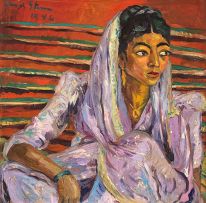19th century, Modern, Post-War and Contemporary Art, Decorative Arts and Jewellery
Live Auction, 18 March 2019
19th century, Modern, Post-War and Contemporary Art
Incl. Buyer's Premium & VAT
About this Item
signed and dated '52
Notes
Alexis Preller's Collected Images (Orchestration of Themes) is an astonishing, lucid, climactic painting. Conceived in a rented Pretorian cottage in the heat of a blazing creative streak, and executed with a cool, mature confidence, it reads as an ingenious and beguiling account of the artist's imagination. Precious, endlessly fascinating, meticulously painted and gorgeously coloured, Collected Images is a landmark, museum-worthy picture.
Relying on a strong, rectilinear, trompe l'oeil composition, the canvas is divided into eighteen equally-sized compartments, each containing an intriguing, Prelleresque vignette or object. The artist picks a single vanishing point, and retains a common sense of scale throughout, even though most compartments recede to different depths. At a glance, it appears as one of the beautifully arranged cabinets of curiosities one might expect to encounter in the artist's mind. What is on display, on closer inspection, is evidence of the remarkable, post-War development of Preller's iconography - a spectacular summary of the artist's distinctive and much-mentioned 'visual repertoire'.
Versions of some of the artist's best-known earlier paintings reappear with only minor refinements or simplifications. Symbols on a Beach (Homage à Bosch), for instance, from 1949, passes through two compartments in the top row (3-4); the mysterious Ritual Mapogga, from 1951, straight-backed but now unveiled, features prominently in the middle row (8), as does Fetish Enthralled, conceived in 1945, and dominated by a thorn-ensnared, smoothly painted Ibo mask (12). The Grotto, an intense, poetic picture from 1946, centred on an urn-shaped head holding a pool of midnight-blue water, appears in the bottom row (17).
Familiar fragments and motifs hint at the artist's early career phases and influences. The wounded, broken sculptures, for example, embody his traumatic wartime experiences as a medic on the frontlines of the North African Campaign (2 & 18); the naked, deformed bodies, impaled for eternity, are pulled from his Hieronymous Bosch fascination (4); the decorative tropical fish, their fins and spines bright and rigid, recall the liberation and joy he felt during his stay in the Seychelles in 1948 (14-15); while Christian icons - Jacob wrestling with the angel (1), the crucifixion (11), and St Sebastian (6) - are typically reimagined in distinctly African settings. Other symbols and devices from earlier, major compositions recur with new details, in isolation, or within different contexts too. Notice the four-legged, Baga-inspired animal form that provided the focal point for The Kraal (5); the ubiquitous, sculptural, melting candles (7 and 15); not to mention the ever-attentive egrets looking heavenward (10-11). That such diverse images could be collected together so delightfully and coherently shows just how eloquent and convincing his visual language had become.
The image in the bottom left compartment (13) - a near restatement of Icarus, a small but hugely important painting from 1951 - gives a possible clue to a broader theme playing out in Collected Images. Not only does its humble egg box provide the larger painting's rectilinear format, but it alludes to the idea of, and the value in, protecting what is fragile, embryonic and cherished. This favoured theme found different symbolic forms throughout the artist's career: in the velvet-lined cello cases, for instance, the elegant cages, the hollowed craniums and empty skulls, the luxurious, body-wrapping blankets, the shells, and the semi-encircling conical structures of the Mapogga. With this in mind, the painting seems to suggest that each collected image - each beautiful creative vision - needs safeguarding and nurturing.
Collected Images went on show at the Galerie Vincent in Pretoria at the end of 1952. This exhibition, which with hindsight remains one of the artist's most outstanding, was opened by Preller's great friend and patron, Norman Eaton. Although the National Gallery of South Africa loaned its Rima and Christ Head to the show, Collected Images was the undisputed highlight. Listed first in the catalogue, and advertised at 150 guineas, the painting was twice the price of the next most expensive pictures, Icarus II and The Martyrdom of St Sebastian. The painting found a buyer in Pretoria as it was listed as a work on loan when exhibited at the HAUM Gallery in Cape Town in the autumn of 1953. It was not released for the artist's retrospective at the Pretoria Art Museum in 1972.
Provenance
L Rutherford.
The Shill Collection.
Exhibited
Galerie Vincent, Pretoria, Alexis Preller, 21 October to 4 November 1952.
HAUM Gallery, Cape Town, Alexis Preller, 28 April to 9 May 1953.
Dennis Hotz Fine Art, Johannesburg, Private Art for Public Viewing, 14 to 22 September 1984, illustrated in colour on page 51 of the exhibition catalogue.
Literature
Esmé Berman (1975) The Story of South African Painting, Cape Town: AA Balkema. Illustrated on page 145.
Esmé Berman (1996) Art and Artists of South Africa, Cape Town: National Book Printers. Illustrated on page 353.
Esmé Berman and Karel Nel (2009) Alexis Preller: Collected Images, Johannesburg: Shelf Publishing. Illustrated in colour on the cover and on page 124.
